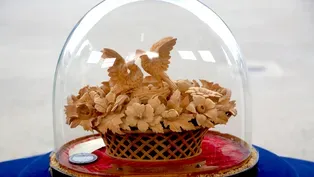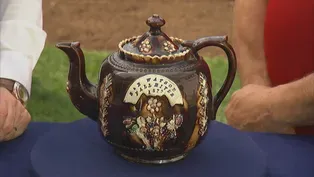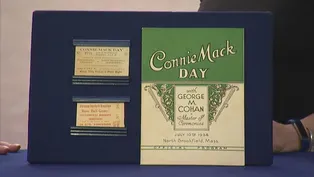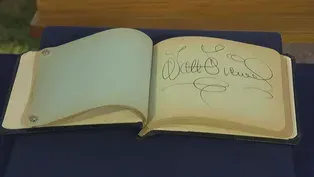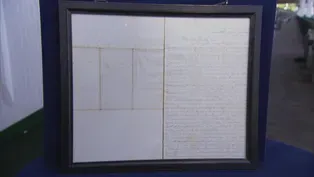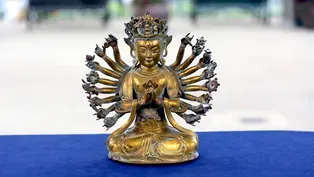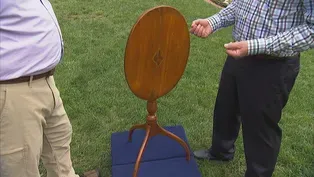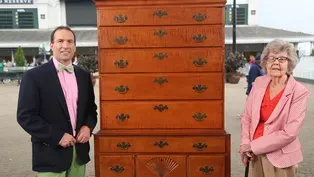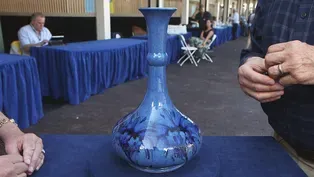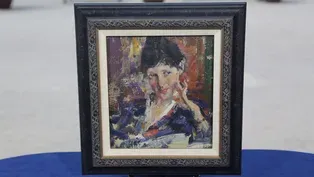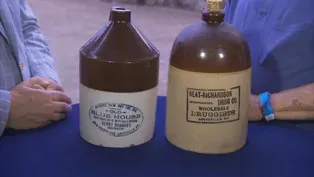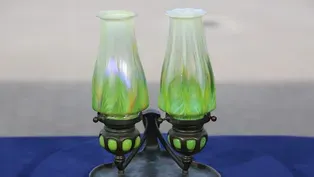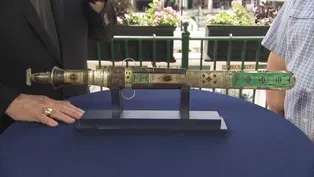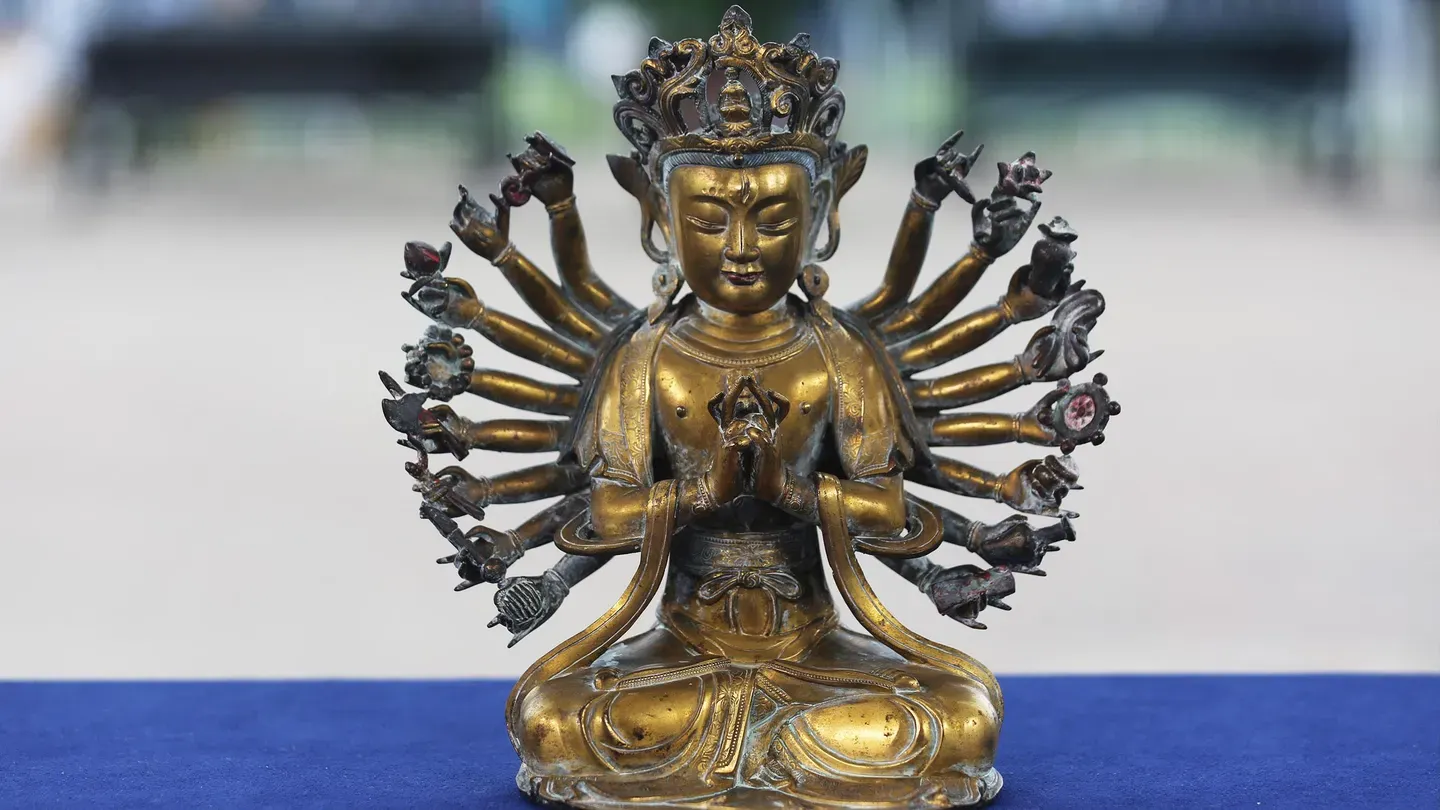

Churchill Downs Racetrack, Hour 3
Season 23 Episode 15 | 52m 28sVideo has Closed Captions
Giddy up for great antiques at Churchill Downs Racetrack!
Giddy up for great appraisals at Churchill Downs Racetrack, such as a Chinese gilt bronze Bodhisattva, ca. 1650, a Nicolai Fechin oil portrait, and an 1861 Fred Kaiffer carved holly sewing box. Can you guess which is valued at $60,000-$150,000?
Problems with Closed Captions? Closed Captioning Feedback
Problems with Closed Captions? Closed Captioning Feedback
Funding for ANTIQUES ROADSHOW is provided by Ancestry and American Cruise Lines. Additional funding is provided by public television viewers.

Churchill Downs Racetrack, Hour 3
Season 23 Episode 15 | 52m 28sVideo has Closed Captions
Giddy up for great appraisals at Churchill Downs Racetrack, such as a Chinese gilt bronze Bodhisattva, ca. 1650, a Nicolai Fechin oil portrait, and an 1861 Fred Kaiffer carved holly sewing box. Can you guess which is valued at $60,000-$150,000?
Problems with Closed Captions? Closed Captioning Feedback
How to Watch Antiques Roadshow
Antiques Roadshow is available to stream on pbs.org and the free PBS App, available on iPhone, Apple TV, Android TV, Android smartphones, Amazon Fire TV, Amazon Fire Tablet, Roku, Samsung Smart TV, and Vizio.
Buy Now

ANTIQUES ROADSHOW 2025 Tour!
Enter now for a chance to win free tickets to ANTIQUES ROADSHOW's 2025 Tour! Plus, see which cities we're headed to!Providing Support for PBS.org
Learn Moreabout PBS online sponsorshipMARK WALBERG: "Antiques Roadshow" is betting on seeing many winning treasures here at Churchill Downs Racetrack in Louisville.
WOMAN: I actually paid a lot more for the frames than I did for the posters themselves.
BOTH: ♪ I'm a Yankee doodle dandy ♪ Exactly.
♪ ♪ WALBERG: Churchill Downs is a place steeped in thoroughbred racing history and tradition.
The lauded racetrack has hosted the Kentucky Derby, America's longest continuous sporting event, since 1875.
Derby traditions are honored every year on the first Saturday in May, when the contest takes place.
But those traditions are celebrated year-round next door to Churchill Downs, at the Kentucky Derby Museum.
Mint julep cups, fanciful hats, and, of course, derby trophies.
All tell the stories of the people and horses who made Churchill Downs such a special place in the world of thoroughbred racing.
♪ ♪ (people talking in background) WOMAN: Hi.
Good morning!
What have you got there?
Is that the right way?
That's the right way, yeah, that's the right way.
WOMAN 2: This is a sign that was part of my father's circus that he purchased in the early '70s.
♪ ♪ MAN: Well, it's an Asian figure that was my grandmother's.
She acquired it probably some time in the late 1800s, early 1900s.
It was given to her by a beau who traveled to Asia extensively and brought her back many objects, and this was one of them.
And she displayed it prominently in her home, and then when she passed, my mother had it, and it was prominently displayed in her home, and now I have it.
I'm assuming it's brass, but I don't know what it represents.
I really know very little about it.
Well, this is a Chinese gilt-bronze Buddha.
And the gilding's in wonderful condition.
It's not been rubbed or worn.
These can be somewhat confusing.
Often, patinated bronze figures that have been highly polished resemble this glowing, illuminating tone.
So at times, one can misidentify a gilt-bronze as one that's been overly cleaned or polished.
But the gilding's in very good condition.
This is from a school of 33 multi-armed deities.
And these represent the bodhisattva of compassion.
The plethora, or multitude of arms, originate in Indian Buddhism, but were incorporated by the Chinese.
At times, these Buddhas are referred to as the thousand-armed Buddhas.
And the multitude of arms are to represent the many ways that this Buddha of compassion will direct, assist, and attempt to guide humanity towards enlightenment.
This is from the 17th century.
Wow.
Circa 1650.
It's in wonderful condition for a bronze from the 17th century.
We are missing a few attributes.
You're usually missing a few fingers.
They usually exhibit some wear.
This is a deity, so this would have been raised on a lotus base, likely a double lotus base.
So it's fit securely into the base.
More than 50% of these multi-armed bodhisattvas that are sold in the marketplace are missing the lotus base.
The lotus base does add a lot of value for that reason.
This is a wonderful object, wonderful casting.
The quality is wonderful.
The eyes are strong.
The nose is strong.
The polychrome to the mouth is still present.
There are red lips.
The quality of the hands...
When you look at a bronze, Chinese bronze, the hands tell you a great deal.
So this is a very, very good bronze.
The work to the jeweled chest, these are jewels to a chest, and this is wonderful lotus banding to the robe.
Very good quality.
I'll turn the bronze around, and we'll see the back.
There is a corrosive pigment, because there's discoloration in the recesses.
Someone may have cleaned it at some point.
You also see cleaning solution and/or corrosive pigment to the front.
And you should have that cleaned and stabilized.
Speaking to value in a retail setting, this would be $40,000.
Wow.
I had no idea.
Absolutely no idea.
That is fabulous.
If this did have the original double lotus base, it would probably have a value of about $150,000.
APPRAISER: A few years ago, you could buy this, and it was, you could afford to restore them.
What's that?
What would it be worth restored?
Restored?
It would cost $1,000 to restore it, or $1,200, and it'd be worth about $1,000, as well, probably.
Oh, okay, so you're not... 30 years ago, he used to come to toy shows, and I'd meet the real Buddy "L." APPRAISER: Nice, stylized painting, mid-century, sort of a modernist view.
But in all likelihood, it's probably not an artist that we're going to have any biographical information about, or probably not somebody that would have exhibited much that we'll drum up any information about.
It might have been more of a hobbyist, but I like it for the look of it.
Where did you get this great vase?
I got it from my great-great-great-aunt.
She lived all over the world and would bring home beautiful things like this.
I've always been told that it was a Chinese Chippendale vase.
But I really wanted to know, so...
Okay, sure.
I have two-- I have a pair.
Oh, you have a pair, okay.
I have another one just like this.
Sure, sure.
They're not... A pair is better.
Well, I didn't want-- in that sack?
Too heavy to bring both of them, huh?
Yeah.
Yeah.
Well, actually, it's not Chinese.
It's actually made in France.
Mid-1800s.
But it certainly has these wonderful hand-painted Chinese figures and the Chinese butterfly and so forth on it.
At one time, everyone called this Old Paris porcelain, or Paris porcelain.
Yes, I'm familiar with that.
Which is a misnomer, actually, because this type of thing, much of it was actually made in the city of Limoges, and in that area.
Right.
Now, it might have been made in Limoges, and then shipped to Paris to be hand-painted.
We don't know.
A single might sell in the $500-$600 range.
But a pair is better.
So if you have a pair in the same condition, probably between $1,200 and $1,800.
Right.
Because of the wonderful hand-painting, the great color-- it's all about the color...
Yes.
And the decorative appeal.
Right.
And when this was new, in the mid-1800s, it was a very expensive luxury item.
Right.
Only affluent, wealthy people could have afforded to buy something like this, of this quality.
WALBERG: In 1896, the length of the Kentucky Derby was shortened from one-and-a-half-miles to one-and-a-quarter-miles long to get better performances from the three-year-old horses racing in the cool spring weather.
Ben Brush, a colt, was the first to race the new distance and win, and the first to receive a garland of roses.
The rose is the official flower of Churchill Downs.
The box is inscribed to Rose Mary Woods, "With appreciation, 1964," and the signature's from Dick Nixon.
Uh-huh.
She was famous for missing tape in the Watergate investigation.
She was personal secretary to Richard Nixon through his entire career.
He had been in an election in 1952, and it was, Eisenhower and Nixon ran and Eisenhower won from 1952 through one term and the second term, then Ike was out of office, and so he ran against John F. Kennedy in another election.
What's great about Rose Mary Woods is that he hired her in 1951.
Fast-forward, he loses to Kennedy and she sticks with him.
He idles until 1968 and he wins the presidency.
So she's the presidential secretary.
That goes well for a few years, and then Watergate hits.
1972 to 1973 is when that all kind of came down on the country.
There was an investigation into Watergate.
Richard Nixon had the tapes from his office, and supposedly during this investigation, she testified that she had accidentally recorded over five minutes of the tape.
Her claim was that she hit a foot pedal on the recording machine and it recorded over.
Some people claim that her foot-- that would be quite a long stretch to reach out and hold that for five minutes.
And it's got a silver hallmark on the bottom.
It's a very finely crafted silver box.
Not quite sure if it's a cigarette box or, you know, a keepsake box of some sort.
Have you ever had anybody authenticate it?
Well, all I can tell you is I bought it from an antique shop here in Louisville.
Mm-hmm.
And when I first saw it, I thought it might be a reproduction.
But what changed my mind was when the owner of the antique shop took me to his back room and showed me a mink stole that had her name in it.
It convinced me that yes, this was an authentic item.
How much did you pay for it?
I paid $400.
Okay, I believe it's worth from $6,000 to $8,000 at auction.
Wow, that's great.
Mm-hmm.
WOMAN: Back in 1995, we cleaned my aunt's house out and I found it buried amongst other items.
Uh-huh.
Old box.
Very surprised to find a flute inside.
No one I know of in the family ever played it.
And it just was very interesting to me.
So I held on to it-- I wonder if at one point, she had some boarders that were there, like exchange students.
Uh-huh.
And maybe it was belonging to one of them.
And where was this?
It's in Antioch, Tennessee.
It's a Haynes flute.
Haynes is one of the top-of-the-line flute manufacturing companies.
And this is a silver flute.
It has what we call a C foot, and it's also what we call a closed-hole.
So where you put your fingers down... Mm-hmm.
Some of them were what we call open-hole and some are closed-hole.
And from the serial number, we can ascertain that this was made in 1922.
Ooh!
These were made in Boston.
This was a professional-quality flute, and they are still professional-quality flutes today.
This is the brand of flute that Jean-Pierre Rampal would play.
To make this in good playable condition, again, it would need to be reconditioned.
It's fairly simple to do, and many people send them back to the factory.
The factory's still making instruments today.
Just because it needs to be reconditioned, and this type of flute, and with this age flute, would have a current retail value as is... Mm-hmm.
Around $1,500.
That's not bad!
(chuckles) No.
If this flute were in reconditioned condition, ready to play, it would have a retail value of $2,000.
Three little kittens lost their mittens.
This one got all the milk.
(laughs) You're looking at 1950s.
Some are a little bit later.
This here is a very typical sapphire diamond line bracelet, 1925, 1930.
This bracelet's, you know, it's got a little bit more going on, it's fancier.
Whose ring is this?
It was my mother-in-law's.
I have it now, so... Oh, it's yours now.
Yeah.
All right.
WOMAN: This is a letter from my husband's great-great-great grandfather to his wife at the end of the Civil War.
And it's come down through the family.
That's great.
And it's a good one to keep, because he is about 35 miles from Lynchburg, Virginia, on April 9, 1865, which is the day that General Lee surrendered the Army of Northern Virginia.
Obviously, the war goes on for a little while longer, but for him, this is the end of the war.
I would say at auction, I would put an estimate of $300 to $500 on it.
Okay!
It's a great letter.
I'm glad we kept it.
I'm glad you did, too.
Yes.
WOMAN: It belonged to my great-grandmother, and she lived in North Brookfield, and attended the event with my grandmother, and kept everything.
And I thought, "Well, this is special."
And I thought, "This is what I'll bring to the Roadshow."
And you did, and you've got the program, and you've got the tickets here.
And we have a bonus.
Yeah.
If you flip this over, you see the signatures of Connie Mack and the hard-to-read signature here of George M. Cohan.
Right, right.
So what did they remember from the day?
Just that North Brookfield is a very small, little village town, and it became 6,000-strong.
Everybody came from all around.
They had a band.
They had parades.
And just the red, white, and blue banners everywhere, and it was so festive.
And why were they celebrating Connie Mack that day?
Because of the fact that they all played baseball on that small field as young boys.
And he's so famous in, in all of New England, but especially living in and born in East Brookfield, but coming to play ball.
And getting George M. Cohan-- they called him "Little Georgie"-- to come on the field and play, yeah.
(laughs) Well, you know, I find it fascinating, seeing the signatures here, that we think about entertainers and sports figures being friends today.
You see that a lot.
But they've had a huge history of that.
And George M. Cohan and Connie Mack are, are no different than that.
Connie Mack, of course, one of the greatest baseball managers of all time.
Yes.
He grew up in East Brookfield.
(laughs) And then you have George M. Cohan, who was best known as one of the greatest entertainers and composers on Broadway.
Correct, yeah.
He created "Yankee Doodle Dandy."
Yeah.
Made famous by James Cagney, exactly.
Jimmy-- yeah.
Who won the Oscar for that performance.
Yes, yes, yup.
BOTH: ♪ I'm a Yankee Doodle Dandy ♪ Exactly.
So George M. Cohan loved the part of East Brookfield where he used to spend his summers.
Do you know what it was called?
Podunk.
(laughing): Oh, of course, Podunk, yes.
It was a small village.
Yeah, yes.
He loved it.
And I can't emphasize this enough, he loved Podunk, but he also called the folks at Podunk Hayseed Hicks.
(laughing) And when he went to Broadway, and he was producing and being in vaudeville and producing his plays, he would often use characters that came from "Podunk..." Podunk.
And that's where they were.
And these entertainers picked up on it, and Podunk went into the vernacular as a small, dull town.
Oh, yeah.
Yup.
We all use "Podunk."
Everybody, and my cousin actually lives on Podunk Road in East Brookfield.
(laughs) So do they say they're from Podunk?
Yes, very proudly!
Well, so, we have this fantastic program.
We have this wonderful history, and the value of the two of them together signing this program for Connie Mack's day, and the tickets on there, look, I would tell you, I would probably insure it for around $1,500.
Wow, that's exciting, thank you.
Fantastic!
(laughs) Well, and I gotta tell you, that's no Podunk value.
No, it isn't, it isn't.
That's very exciting.
(people talking in background) I don't believe this would be signed.
You know, it's the type of painting that's an Old Master painting, which invariably aren't signed, so, but...
It's a decent work.
But it's just suffered too much through all the years.
Okay.
What is that?
WOMAN: I don't know.
I mean, I think it's, like, an old musical instrument of some kind, but I don't really know.
Okay.
Well, we have a couple of old musical instrument people here, so they should know about that stuff, okay?
Great.
MAN: So my grandmother, who came here from Portugal, gave it to my mother, and my mother gave it to me before she passed about ten years or so ago.
APPRAISER: All right.
So it's been in the family for at least 60, 70 years.
Now, there's a name on there, "Fall River."
Is that where your family was from?
Fall River, yeah.
We settled into Fall River back in the 1910 era.
Well, there's a lot of history between Massachusetts and tea.
(laughs): Oh, yeah, there is.
And it kind of goes back to England, where this teapot comes from.
Oh, okay.
It's what we call bargeware, and bargeware is very distinctive.
It typically has this rich, brown, chocolaty Rockingham glaze, we call it.
And then it's punctuated with these very colorful applied, mostly flowers, and other things.
And bargeware is very typically either dated or inscribed with the name of someone.
It's called bargeware because it was popular with people who lived on and operated narrow boats, the barges that operated the canals.
And much of it was made in the county of Leicestershire in England, near a little town called Measham.
So it's sometimes called Meashamware.
If you didn't know that Fall River was in Massachusetts, you might think it was somewhere in the British Isles.
But here it tells us "North America."
And I spoke to some of my colleagues-- none of us had ever seen a piece of bargeware with a North American reference before.
If it wasn't of North American interest, it might be worth $150 or $200.
Mm-hmm.
But it isn't.
It's got that twist to it.
So, again, we thought about it.
And I'm going to give you a value that I think is fair for replacement or insurance.
Okay.
That's $2,000.
Wow.
Great thing.
Wow.
Well, that's great news.
Thank you very much for that insight on it.
♪ ♪ WALBERG: In the racetrack's infancy, it would have been indecent for a woman to attend a race without a hat.
Now, it's a tradition and spectacle.
With over 100,000 guests attending the race on any given Kentucky Derby day, that's a lot of fancy hats.
♪ ♪ MAN: My great-great-grandmother lived in Mineral Point, Wisconsin, in the late 1800s.
They moved to Chicago, and they were a pretty well-to-do family.
Then they lost everything they had in the Great Depression.
They didn't lose this.
No.
And you don't know at all how the damage occurred over all those years.
No, I don't.
So this is a Tiffany chamber stick.
The bronze is a little bit as is, but not enough to really hurt the value.
So we want to talk about what hurts the value.
The shades are Tiffany opalescent glass.
So one of them is chipped, and one isn't.
What I'd like to do, if you could help me, is to unscrew the screws.
Sure.
And take these shades out so we can see the perfect one and see the damaged one.
And they just lift out.
And I, I-- I have-- I'm the winner.
I have the damaged one.
(chuckles) So this is your fitter rim.
Okay.
And yours should be perfect.
We're going to turn this over, and we have the Tiffany Studios mark right here with the number 5640.
And that's a pattern number.
These are circa 1905.
Circa... Now, if we'll put this back down.
Great.
And if you could carefully put your little end in.
You've done this a few times, I know.
Sure.
And even though we're missing one screw on the one I'm doing, it still holds it tight enough, but you definitely want to replace the screw.
Okay.
The bottom parts are bobeches.
And they hold blown Tiffany glass in there.
So when we get talking about damage on important pieces, we have to get down to the nitty-gritty of damage.
You can see that this particular bobeche has cracks and chunks out of it.
Right.
It happens to be one of the most difficult restorations you can find on a piece.
Okay.
About all you could do is find a new bobeche.
Not an easy task.
What happens to value when these things occur?
In the condition that this is in, in a fine retail establishment, you would find this in a range of $3,000 to $4,000.
Wow, that's, that's... That's pretty good for all that damage.
That's very good.
Yes, it is.
If it's possible to find a bobeche, now your piece would be worth $12,000.
It's just pretty.
WOMAN: It's pretty?
Tell me again what it is.
Corner clock shelf, but he told us it was just a corner shelf.
WOMAN: Corner shelf.
How much is it worth?
$150-ish.
(quietly): I paid $100 for it.
And we had great fun.
WOMAN: I've frequented the thrift stores over the years, and back in what I think was the mid to late '80s... (laughing): I went to the fine arts department at the thrift store.
Okay.
And I found this piece.
And I've always loved it and have just kind of taken it from house to house.
Okay.
Now the big question: what did you pay for it?
$2.52.
$2.50.
Okay.
And do you know who it's by?
No.
I've never been able to read the signature.
So I've always just enjoyed it.
The signature is up here, it's a little indistinct.
Uh-huh.
But this is by an artist called Earl Kerkam.
K-E-R-K-A-M. Now, he was a very successful, well-paid commercial artist who gave it all up to become a fine artist.
Uh-huh.
And he studied in New York at the Art Students League, amongst other places.
Went to Paris, exhibited with André Derain, who was one of the leading Fauves, came back in the 1930s, and really committed himself to becoming a painter.
This is unusual for him.
He didn't do too many still-lifes.
He tended to do more self-portraits and figurative paintings.
Oh, uh-huh.
It's oil on board.
But when we look at these lines, these are actually drawn in with crayon, on top of the oil paint.
In terms of when it was painted, my guess would be around about the '40-'50s.
Now, although he knew people like de Kooning and Pollock, and worked with them in the WPA program... Really!
He didn't make that big leap into Abstract Expressionism that they did.
He was pretty much a disciple of Cézanne and Cubism.
So he wasn't a radical as such.
He passed away in 1965.
And a letter was written to the directors of the Museum of Modern Art in New York, saying-- and I think this is verbatim-- "In our eyes, one of our finest artists to come out of America."
The signatories of that letter included Willem de Kooning... Oh, my goodness... Hans Hofmann... Oh, my goodness... Philip Guston... Mm-hmm.
And Mark Rothko.
Mm-hmm.
Amongst others.
So there you have the heavy hitters of Abstract Expressionism... My gosh, yes.
Saying this guy deserves a memorial exhibition in the Museum of Modern Art.
Now, the market hasn't been perhaps as kind to him, but I think this is a lovely little painting.
And in auction terms, I would expect you to get somewhere around about $1,500 to $2,500.
Okay.
So two bucks and 50 well spent.
(laughs) Thank you.
Thank you.
MAN: I got it at a local auction near our home.
APPRAISER: What did you pay for it?
I paid about $150 for it.
Did the auctioneer give you any information?
He thought it was a Moroccan sword, and after I purchased it, he said he thought we got a pretty good deal on the thing.
All right, well, let's see if you did.
First of all, this is from Niger.
It's Tuareg, and this particular kind of sword is called takouba.
And a Tuareg warrior would have carried a sword like this and a lance.
And as fine and as fancy as this is, this also would have been a status symbol.
It would have indicated how important he was as a warrior.
And I want you to look at the silver area that's inscribed, the beautiful leather work.
This is really an extraordinary thing, and this... By the way, these stones are carnelian stones.
Oh!
So it's a great example.
Probably dates to the early 20th century, and at a good auction, I would expect this to be $800 to $1,200.
Not bad!
Not bad at all.
Congratulations.
Well, thank you very much.
♪ ♪ WOMAN: I brought my antique curly maple highboy.
My husband and I collected antiques for a long time.
And we had a friend who was in the business, sort of, and he got it for us.
Oh, really-- excellent.
Yeah.
And what did he tell you about it?
That if you collect antiques, you ought to have a highboy.
Well, he's certainly right.
It's the cornerstone for any collection.
Now, did he give you any sense of how old it is or where it's from?
No.
But I got the feeling it was from... New England and Connecticut.
Well, excellent.
And what gave you that feeling?
Because that's where he got most of his antiques.
Most of his antiques?
Do you remember when you bought this?
Well, it was before 1964.
Oh, really.
Yeah.
Any idea what you paid for it?
No, I don't remember what we paid for it, but it was substantial.
Several thousand dollars, I'm sure of that.
Several thousand.
When we look at a piece of furniture, we look at the form.
Right.
Did the form exist in the 18th century?
And the answer is, absolutely.
This relates to the Queen Anne period, which is something that would have been made between about 1740 to 1760.
That's old.
Absolutely.
The next question we look at is, what's it made of?
Was this something that would have been used in the period?
It's called figured maple or tiger maple, and that is absolutely a native wood to America that's found in New England.
So you are right.
This is something that would have been made in New England.
You've got this fabulous figured maple that draws the eye up.
But there's also another element on here that's a neat decorative feature, which is this fan.
Yes.
Well, when I look at the fan, I say, "Is that something that I would see in the period?"
It looks like a handheld fan, something you'd cool yourself with.
And during the period, we would have expected to see a demilune fan, a semicircle with a flat bottom that runs parallel to the edge of the drawer.
And the other feature about this that is a little unusual is the shape of this foot.
This is what we call a trifed foot.
And it's really unusual to find a trifed foot on a New England piece of furniture.
So a little bit of alarm bells are starting to go off.
You'd expect to see a pad foot.
If I pull this drawer out, and I pull this drawer out, I want to compare the top and bottom to each other.
Right.
And if we look at the dovetails, you'll see on the bottom drawer, there's one large dovetail.
Right.
And up top, they're smaller.
That to me says we've got an issue.
It should be uniform construction throughout the case.
What I think you have here is a high chest that's been married.
Which cuts its value.
It does cut its value.
Have you ever had it appraised?
Oh, in the early '90s, we had someone look at it for a fine arts insurance.
And do you remember what they appraised it for?
No, not really.
Maybe $9,000, something like that.
Well, $9,000 would have been a pretty significant figure.
But if you have what we call a married or an assembled chest, the marketplace sort of views it as just a decorative object now.
Right.
So if I were to appraise it for insurance purposes in 1990, I probably wouldn't have put more than $1,500 to $2,000.
If this were to come up at auction today, I would place a conservative auction estimate of $500 to $1,000 on it.
Is that all?
That's it.
Uh-oh.
Well, I hope I didn't ruin your day.
No, you didn't.
You didn't ruin my day at all.
But... You know...
It's been a lovely day.
And my wife had it from her mother, and she had had them on display.
We have them on display in our bookcases.
They just look nice.
And I was trying to find something to bring.
(laughs) It's just pure looks, and that's it.
They look good in our bookcase.
So, yeah, Frankenstrat, and it probably plays good.
It does, it sounds really good.
But it takes a real man to hang this on...
Pretty heavy.
It seems this is the only Strat we've seen today.
You're kidding.
We usually see a lot of them.
Well, yeah... MAN: Well, what little I know about them.
I probably purchased them about, oh, 30, 35 years ago.
And I either got them at an auction or a yard sale.
I probably gave them around $20 for them apiece.
And as far as the age, I don't know the age or don't know what...
I've never had them appraised or nothing.
Okay.
That's about the extent of what I know of them.
All right.
Well, these jugs tell a long story for me.
When I very first got in the antiques business, one of the first places I went was to an attic in a barn, or a loft, and the family had been there in that house since back in the 19th century.
And upstairs was a moonshine still and about 50 jugs like this.
Yeah.
So from that day on, I always called them moonshine jugs.
Yeah.
And what they are is, they're factory-made stoneware pottery.
And usually when you see them like this, when the sides are straight like that, that tells you that it's, like, up around 1900.
And usually when you see the brown, and the tan on the bottom, that tells me that it's later in the 19th century, early 20th century.
But your jugs have an even better story to tell, and we can drop the moniker of moonshine and add bourbon.
Because here we are in, in the...
Right.
Bourbon country.
We are in the middle of bourbon country.
And back then, if you wanted to buy whiskey, you could buy a whole jug of it.
You might go to the bar to do it, or the drugstore.
Right, yes.
I guess if you felt bad, you went to the drugstore to get it.
If you wanted to feel good, you went to the... (laughing): You went to the local saloon to get it.
Right.
Yes, sir.
And this one over here is fabulous.
Yeah.
It's from a saloon, and it says, "Nothing new but the jug."
Right.
So we know it was good, aged Kentucky bourbon.
Jugs like this are selling online anywhere from $200 to $300 each.
Oh, that's, yeah, surprising.
And, you know, the one from the saloon...
Right.
...is probably the better of the two.
Right.
Because it has that saying on it.
Yes, sir.
Well, that's surprised me.
That's more than I thought they would be worth.
I have to thank my sister, because she got the tickets for the Antiques Roadshow.
(laughs) (bell ringing, hooves pounding) WALBERG: As the host of the Kentucky Derby since 1875, Churchill Downs Racetrack is the place for the most exciting two minutes in sports.
However, financial success for the venue in its early days proved elusive.
It took 28 years from its founding for Churchill Downs to show a profit.
MAN: This is a functional sewing basket that was carved by my great-uncle Frederick Kaiffer in the 1860s.
It won the award for the best carved work at the New York Exposition in 1865.
It's been in our family for all those years.
It's made out of three pieces of holly wood.
Frederick Kaiffer was a noted designer.
He was a wood carver who carved a lot of altars for churches.
He carved the original pattern for the jockey, the cast-iron jockey.
He operated out of New York City.
He was married to my great-aunt, and he must have been quite a bit older than her, because he died in circa 1915, and I remember meeting her when I was a young boy in the '50s.
Okay.
So she lived for 40 or 45 years after he passed away.
So what you have here is a truly spectacular tour de force of Frederick Kaiffer's work.
It has this lovely plaque, likely carved by him, as well.
It says, "This basket was carved, 1861, by F.
Kaiffer."
And as you had noted, it's made of holly wood in three pieces.
And that information is on the piece of document listed closest to you.
And then we also have the medal, as well, which he was awarded, which is inscribed with his name, with the date of 1865.
I was able to do some research on him.
And based upon New York State Assembly documents, he received a diploma award for a spectacular wood carving specimen, and that was printed in 1864.
Surprisingly, as an illustrious career as he's had, we have little to no auction records or sales records for his works, and that's most likely because he chose not to sign the pieces.
What's really lovely about this is, he was clearly of German descent, because this really resembles Black Forest carving, which, where we see these wonderful carved birds here over the nest with the eggs, surrounded within this wonderful floral bouquet.
So you say it's an operating sewing box.
Is it possible you could open it for us?
Sure.
Wow, look at that.
Okay, so this is really lovely to see inside.
And I've never seen the inside of it.
Really?
I knew it was a functional sewing basket, but I just thought it was void in there.
We've got the first level here, which is this wonderful removable insert.
I can see it's removable, and it's paper-lined.
And then you have down to a second tier, as well, again, paper-lined and divided.
And there's two screws.
Oh, yeah.
In the bottom.
So it can't come off.
So it can't come off, so it won't fall off, which is actually very good.
So as you can see, lovely fitted interior for sewing.
I'm going to go ahead and put this back on.
And if I could ask you to very carefully put the lid back on again, that would be wonderful.
Every time I look at the lid, I see something new.
Is-- is there any finish on it, or do you think this is just raw wood?
This is completely raw wood.
Raw wood-- no finish at all.
There's no finish at all.
What's interesting about this is, the color hasn't changed hardly at all, because...
I see that, yeah.
Wood changes color by oxidization, by aging with the exposure to oxygen.
And this is kept under a glass dome, so the color is almost as it would have been the day he carved it, which is truly wonderful.
It is an exceptional piece.
If you were to have this piece insured, I would recommend an insurance value of somewhere between $15,000 and $20,000.
Okay.
♪ ♪ The quality is there.
It's just, it's not 400 years old, right?
Okay.
I mean, we have to just deal with the... We'll settle, we'll settle for 200 years.
Yeah, just 200.
Okay.
WOMAN: When I would come home from college when I was in my 20s, I noticed this new addition to the living room, and I thought it was pretty.
But I was really busy and I didn't pay a lot of attention to it.
But then as my mother got older, one day I found it in my bedroom.
And I realized that she wanted me to have it.
And upon her passing, it came to me.
And I've had it ever since.
We never talked about it.
I just admired it and said, "Oh, it's a pretty piece."
Okay, you know it's Moorcroft.
Yes, I looked on the bottom.
And what I've noticed, it's just such a pretty color.
That it's...
It's, it's a very unusual color.
It's a cornflower design, which is one that you see in quite a bit Moorcroft.
But the glaze is called powder blue.
And it's a blue on blue.
It's a really beautiful glaze.
It has the speckling in it.
That's very typical of the powder blue glaze.
Dates from around 1935.
And you see the raised areas where the flowers are?
Yes.
That's done with tube lining.
It's like squeezing toothpaste out of a tube, but a thin line.
And they would tube line the design on here, and then women would come in and put the colors on.
Wow.
So it's a two-step process.
Then the glaze would be put on it, and it would be fired.
And it's really a beautiful shape, beautiful form, and nice glaze there.
Well, thank you.
I've-- it's in a prized place in my home, and I've always enjoyed it.
And I have lots of cats and dogs running around.
So I do have it in a secure place.
Have you thought about value?
Well, yes, actually, I have.
And...
I don't know.
My mother never said a thing about value.
We didn't talk about stuff like that.
But I would say $300, maybe?
Well, let's bump that up a little bit.
In today's market, it's probably, at auction, would bring somewhere between $1,200 and $1,700.
Wow!
So, yeah, wow.
(exhales) It's a beautiful piece.
It's big, has a lot going for it, and in pristine condition, so...
Thank you so much.
I'm, I'm stunned.
Well, good.
I'm going to put it in an even safer place.
Yeah, keep the cats and dogs away, and...
I'll do my best.
It's nice, it's sweet.
This is a collection of baseball schedules, I hope from 1898.
I got these as a gift from one of my dad's friends and co-workers when I was really young, five or six years old.
I don't know much about them.
I was not able to find any information about them online.
I do know that in 1898, there were 12 professional baseball teams.
Okay.
And there's 12 schedules here.
Other than that, that's about all I know.
I've never seen a complete set of the playing card schedules like this.
It's all 12 teams in the 1898 National League, including, we have to start with St. Louis, Baseball Club.
Then we have the Boston Bean Eaters.
The New York Giants.
And then what I'm most excited to see today is the Louisville Colonels.
So, of course, the Louisville Colonels were only the Louisville Colonels from 1885 to 1899.
But then when the owner bought a part-interest in the Pirates, the team folded, and Louisville Colonels memorabilia is very scarce.
These were inserted in playing cards.
And what's interesting, none of these came from the same deck.
So somebody had to put this collection together one at a time to do the complete set of 12, had them riveted so you could fan them out, keep them together.
And it's really incredible to see a complete set like this.
I've never seen or heard of one in existence.
Wow.
I would put this group at auction of a value of $2,500 to $3,000.
That's outstanding.
I never expected that.
♪ ♪ (PEOPLE TALKING IN BACKGROUND) I FOUND THEM AT A YARD SALE.
I GOT ABOUT 30 OF THEM FOR SOMEWHERE AROUND $20.
I WANTED TO KNOW A LITTLE BIT MORE ABOUT THEM.
SOME OF THEM ARE SIGNED, SO I WANTED TO KNOW A LITTLE BIT ABOUT THE ARTISTS.
SO $20 FOR 30 POSTERS.
YES.
AND HOW LONG AGO DID YOU BUY THEM?
12... YEARS, 15 YEARS?
AND SINCE THEN, WHAT HAVE YOU BEEN DOING WITH THEM?
THEY'VE BEEN IN PICTURE FRAMES IN MY HOUSE.
IT'S NOT INEXPENSIVE TO FRAME 30 POSTERS.
NO.
I ACTUALLY PAID A LOT MORE FOR THE FRAMES THAN I DID FOR THE POSTERS THEMSELVES, AND GOT IN A BIT OF TROUBLE WITH MY HUSBAND FOR IT.
PAID AROUND $2,000 FOR THE PICTURE FRAMES FOR ALL OF THEM.
AND I GOT YELLED AT QUITE A BIT UNTIL HE HAPPENED TO SEE AN OLD "ANTIQUES ROADSHOW" EPISODE.
FASCINATING.
SO THIS COULD BE ONE OF THE VERY FIRST EXAMPLES WHERE THE ROADSHOW COMES TO SOLVE OR CURE...
SAVED ME.
...A FAMILY ISSUE.
OF THE 30, I PULLED OUT FOUR, AND THESE FOUR ALL HAVE SEVERAL THINGS IN COMMON.
ONE THAT IS FAIRLY OBVIOUS IS, THEY'RE ALL FOR PAN AM AIRLINES, PAN AMERICAN AIRLINES.
THE OTHER THING, OBVIOUS BUT NOT QUITE AS OBVIOUS, IS THAT THEY'RE ALL BY THE SAME ARTIST, AMSPOKER.
THIRDLY, THEY ARE ALL SILKSCREENS.
THAT'S THE PROCESS BY WHICH THEY WERE PRINTED.
AND THE FINAL THING, WHICH IS PROBABLY THE MOST ESOTERIC, IS THAT IT WAS UNUSUAL AT THE TIME FOR THESE POSTERS TO NOT FEATURE IMAGES OF THE AIRCRAFT.
THESE POSTERS ARE ALL FROM THE 1950S.
WE SEE THE PACIFIC AND NEW ZEALAND.
WE SEE EUROPE.
WE SEE ASIA.
WE SEE SOUTH AMERICA.
SO IT REALLY IS, LIKE, A BROAD SAMPLING OF THE ENTIRE NETWORK THAT PAN AM HAD TO OFFER.
AND WE'RE ALSO GREETED WITH THE SLOGAN "THE WORLD'S MOST EXPERIENCED AIRLINE."
THESE POSTERS ARE POPULAR WITH COLLECTORS FOR SEVERAL REASONS.
YOU SOMETIMES HEAR ABOUT REAL ESTATE, THAT THE MOST IMPORTANT THING IN REAL ESTATE IS LOCATION, LOCATION, LOCATION.
A SIMILAR OBSERVATION CAN BE MADE ABOUT TRAVEL POSTERS-- DESTINATION, DESTINATION, DESTINATION.
OFTENTIMES, THE MORE POPULAR OR THE MORE EXOTIC A DESTINATION IS, AND THE BETTER THE IMAGERY FROM THAT EXOTIC DESTINATION, THE MORE VALUABLE THE POSTER IS.
THE OTHER THING THAT MAKES THESE POSTERS COLLECTIBLE IS THAT THERE IS A WHOLE SUBSET OF COLLECTORS WHO REALLY ARE PASSIONATE ABOUT PAN AM.
PEOPLE COLLECT THESE NOT JUST FOR THE IMAGERY, NOT JUST FOR THE DESTINATIONS, BUT ALSO BECAUSE THEY ARE PAN AM-IANA.
THESE ARE ALL BY THE SAME ARTIST, DONE IN THE 1950S.
UNUSUALLY, THERE IS VERY LITTLE BIOGRAPHICAL INFORMATION ABOUT THIS ARTIST AVAILABLE.
THERE ARE SOME ARTISTS WHO BECAME FAMOUS, BUT AMSPOKER REALLY NEVER AMOUNTED TO MORE THAN THIS SET, AND HE DID ABOUT 20 DIFFERENT POSTERS FOR PAN AM, AND THE SERIES ENDED IN 1959.
OF HIS WORK, ONLY ONE OF THESE HAS COME UP FOR AUCTION BEFORE, AND THAT'S THE NEW ZEALAND PIECE.
AND BASED ON THE PRICE THAT IT AND SEVERAL OTHER OF HIS IMAGES HAVE SOLD FOR AT AUCTION, I WOULD ESTIMATE EACH ONE OF THESE BETWEEN $600 AND $900, RIGHT?
SO THE GROUP OF JUST THESE FOUR WOULD BE BETWEEN $2,400 AND $3,600.
AND THE THING IS, AT ONE POINT IN 2007, SO 11 YEARS AGO-- WHICH WAS THE HIGH-WATER MARK, RIGHT BEFORE THE BIG CRASH OF 2008-- IN 2007, THE HIGH-WATER MARK FOR THE NEW ZEALAND POSTER WAS $1,600.
SO IT'S REALLY POSSIBLE... PEOPLE ALWAYS ASK ME, "SHOULD I HOLD ON TO THEM?
MIGHT THEY BE MORE VALUABLE LATER?"
AND I RARELY SAY YES, BECAUSE WE DON'T REALLY KNOW.
BUT IN THIS CASE, IT SORT OF SEEMS LIKE THE MARKET IS COMING BACK, AND IT MIGHT BE WORTH HOLDING ON TO THEM FOR A FEW MORE YEARS.
OKAY.
AND ARE THEY MORE VALUABLE AS A COLLECTION OR SEPARATELY?
THEY ARE MORE VALUABLE SEPARATELY.
WOW.
REALLY A MAJOR SCULPTOR.
WE DON'T SEE MUCH OF HIS WORK IN THIS COUNTRY.
I MEAN, IT'S A REALLY POWERFUL PIECE, THE WAY THIS FIGURE IS FORMED.
SORT OF HAS A REAL EXPRESSIONIST LOOK TO IT.
IT'S REALLY... QUITE A WONDERFUL PIECE.
THIS IS AN 1862 CIVIL WAR RIFLE THAT'S BEEN RETROFITTED WITH A SIDE BREECH.
IT WASN'T USED IN THE MILITARY BECAUSE OF A FLAW.
IF YOU HALF-COCK IT, THEN THIS OPENS UP.
(LAUGHING): AND YOU'RE GOING TO LOSE YOUR CARTRIDGE, SO...
In the first year of Disneyland's opening, there was a contest in the "Detroit Times," and it was in the comics section, and you were to name a monkey.
And there was a caption of it, "As much fun as a barrel full of monkeys."
So we called him "Phillip McFun Barrel," and it won.
(laughing) And we won a trip to Disneyland in its first year of opening.
And the studios, lunch with the Mouseketeers, and meeting Mr. Disney.
And, of course, the park.
It was a great fun time.
Well, now you have this great photograph of you and all these other winners.
Now, which one are you?
I'm the one laughing at the end.
So over on the very end is you.
Now, were all these other, like, children winners?
Yes.
They were from Maryland and Wisconsin and Massachusetts, and one from Texas.
Now, did they all have to name the monkey, also?
They named him different names.
Who had the best name?
I think I did.
(laughing) Well, you brought in this wonderful autograph book.
And in the autograph book, you have the Mouseketeers.
You have various voice actors from the Disney Studios.
But you have one in particular.
Yes.
Walt Disney.
Yes.
That's the best of all.
He helped in the tour of the studios.
And we got to go in and see the animators.
And, of course, at that time, it was something you never even knew about, how they made the cartoons.
Just really amazing.
When I look back at it, it was one of those things you're not quite sure was real.
So this was a really amazing moment in the history of the Disney company.
They had just opened an amazing theme park.
They were putting out such amazing films.
And in this autograph book, you have a lot of different signatures, but the most valuable one is Walt Disney's autograph.
And for an authentic Walt Disney, an insurance value on that would be around $1,500 to $2,000.
And the rest of the signatures are around $500 to $1,000.
Great, just wonderful.
Oh, that's so nice.
That's really nice to hear.
And it has such great memories with it, thank you.
I have a bell... ...that's very old.
(laughs) And it rings.
(clicks) (ringing) That's very old.
(laughs) WOMAN: We went to a yard sale and we picked it out.
APPRAISER: Lovely.
How much did you pay for it?
A couple of bucks, like, two dollars.
MAN: My mother purchased it probably in the early '60s.
APPRAISER: It's a great design.
Yeah.
This cabinetmaker knew how to make it dance, if you will.
Oh, really.
And in spite of being a country stand, I mean, there was some effort to make it look more like a city piece of furniture.
That inlaid panel, okay, with that chevron banding?
The post itself is fairly delicate.
This table has lift.
It's very nice.
Those legs taper to the point of where they really look delicate.
It's kind of amazing it survived.
Yeah.
And when you set it back in that position, you continue to see just how lovely it is.
And we can highlight this checkered banding on the top.
So have you had it appraised in the past?
Never.
All right.
So I think this stand, in light of those positive attributes that we've, we've ticked down here... Yeah, yeah.
I would estimate it, you know, for auction purposes, being quite sure that it's from New Hampshire, and it's a much better quality than many stands, probably $1,000 to $1,500.
So... Really?
And when-- how old is that?
You say it's...
This, this would be a Federal stand.
Probably made, I would say, about 1800, 1810.
Is that right?
Yeah.
♪ ♪ WOMAN: That is my grandmother.
She was from Kazan, Russia, and I understand that Nicolai Fechin was from Kazan, Russia, as well.
They both ended up immigrating to the United States, I believe some time in the 1920s or so.
And she ended up taking art lessons from him in New York City.
APPRAISER: They're two immigrants.
After the Bolshevik Revolution, and also the war, the situation in Russia was, was very problematic.
So Fechin moved to the United States in 1923, and lived in New York City.
And during that period, he was painting portraits for which he was very well known, and also teaching.
And that, I suspect, is where your grandmother... My understanding was that she took painting lessons from him in Greenwich Village.
How wonderful.
That's what my mother told me, anyway.
Well, mothers never lie.
That's right.
That is correct.
In 1926, he moved to Taos.
He had tuberculosis.
And in Taos, he really came into his own, and some of his really famous paintings come from the Taos period.
But this painting has everything Fechin ever thought of.
It's very personal.
During a phase of his career, he would often paint the background first.
Oh, wow.
And then allow the features of the figure to come out in a very evocative way.
And that's what I was referring to earlier when I said that she seems to emanate from the background.
He had a very distinctive style.
He painted with a palette knife and his thumb.
He was a very hands-on painter, and has become one of the most important American 20th-century portraitists.
Wow.
It's a beautiful portrait.
It is...
Thank you-- I've always loved it.
She looks like quite a character, and he was able to catch that very beautifully.
So we're dating it probably around the '20s.
It's oil on canvas.
Beautiful condition.
At auction, I would estimate it between $60,000 and $80,000.
Whoa!
(laughs) And for insurance, about $150,000.
Well, that's a nice little piece to have on the wall, I guess.
WALBERG: And now it's time for the Roadshow Feedback Booth.
Today I brought a plate and a plane which I thought were antiques.
It turns out that I'm older than they are, so I guess I'm the antique and they're not.
But they were worth way more than I thought.
So it's been a great day at "Antiques Roadshow."
And my-- our picture-- I got a picture, and if I get it to the U.K., I can get almost $500 out of it.
(chuckles) All right, thanks.
This is supposed to be 600 years old.
As it turns out, it's about 600 days old.
And I brought my husband's 69-year-old Superman watch, which I thought was a piece of junk.
I learned that it's worth between $150 and $200.
And it doesn't even work.
And today I brought my Chinese ritualistic wine vessel, and these were used about 3,000 years ago, from what I found out today, and, unfortunately, mine is made post-1980 and only worth about $30 or $40.
So I think I'll just drink out of mine.
And this is the perfect appliance for dispensing toothpicks at the table.
A little spring-loaded woodpecker.
And I've had a ball today, and thanks to Kentucky Educational Television, I'm an "Antiques Roadshow" fanatic.
So thank you guys.
And that's all.
WALBERG: I'm Mark Walberg.
Thanks for watching.
See you next time on "Antiques Roadshow."
Appraisal: 1861 Fred Kaiffer Carved Holly Sewing Box
Video has Closed Captions
Clip: S23 Ep15 | 3m 46s | Appraisal: 1861 Fred Kaiffer Carved Holly Sewing Box (3m 46s)
Appraisal: 1879 Bargeware Teapot
Video has Closed Captions
Clip: S23 Ep15 | 2m 3s | Appraisal: 1879 Bargeware Teapot (2m 3s)
Appraisal: 1898 National League Playing Card Schedules
Video has Closed Captions
Clip: S23 Ep15 | 1m 38s | Appraisal: 1898 National League Playing Card Schedules (1m 38s)
Appraisal: 1934 Signed Connie Mac Day Program & Tickets
Video has Closed Captions
Clip: S23 Ep15 | 3m 14s | Appraisal: 1934 Signed Connie Mac Day Program & Tickets (3m 14s)
Appraisal: 1956 Disneyland Autograph Book
Video has Closed Captions
Clip: S23 Ep15 | 2m 12s | Appraisal: 1956 Disneyland Autograph Book (2m 12s)
Appraisal: A. Amspoker Pan Am Posters, ca. 1955
Video has Closed Captions
Clip: S23 Ep15 | 3m 51s | Appraisal: A. Amspoker Pan Am Posters, ca. 1955 (3m 51s)
Appraisal: April 9, 1865 Civil War Letter
Video has Closed Captions
Clip: S23 Ep15 | 49s | Appraisal: April 9, 1865 Civil War Letter (49s)
Appraisal: Chinese Gilt Bronze Bodhisattva, ca. 1650
Video has Closed Captions
Clip: S23 Ep15 | 3m 13s | Appraisal: Chinese Gilt Bronze Bodhisattva, ca. 1650 (3m 13s)
Appraisal: Earl Kerkam Oil Painting with Crayon, ca. 1950
Video has Closed Captions
Clip: S23 Ep15 | 2m 28s | Appraisal: Earl Kerkam Oil Painting with Crayon, ca. 1950 (2m 28s)
Appraisal: Federal Inlaid Tilt-top Candlestand, ca. 1800
Video has Closed Captions
Clip: S23 Ep15 | 1m 23s | Appraisal: Federal Inlaid Tilt-top Candlestand, ca. 1800 (1m 23s)
Appraisal: Married Queen Anne Maple High Chest
Video has Closed Captions
Clip: S23 Ep15 | 3m 53s | Appraisal: Married Queen Anne Maple High Chest (3m 53s)
Appraisal: Mooncroft Cornflower Vase, ca. 1935
Video has Closed Captions
Clip: S23 Ep15 | 2m 28s | Appraisal: Mooncroft Cornflower Vase, ca. 1935 (2m 28s)
Appraisal: Nicolai Fechin Oil Portrait, ca. 1925
Video has Closed Captions
Clip: S23 Ep15 | 2m 32s | Appraisal: Nicolai Fechin Oil Portrait, ca. 1925 (2m 32s)
Appraisal: Stoneware Advertising Jugs, ca. 1900
Video has Closed Captions
Clip: S23 Ep15 | 2m 16s | Appraisal: Stoneware Advertising Jugs, ca. 1900 (2m 16s)
Appraisal: Tiffany Studios Chamberstick, ca. 1905
Video has Closed Captions
Clip: S23 Ep15 | 2m 54s | Appraisal: Tiffany Studios Chamberstick, ca. 1905 (2m 54s)
Appraisal: Tuareg Takouba Sword, ca. 1910
Video has Closed Captions
Clip: S23 Ep15 | 1m 19s | Appraisal: Tuareg Takouba Sword, ca. 1910 (1m 19s)
Providing Support for PBS.org
Learn Moreabout PBS online sponsorshipSupport for PBS provided by:
Funding for ANTIQUES ROADSHOW is provided by Ancestry and American Cruise Lines. Additional funding is provided by public television viewers.


